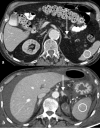Bilateral adrenal enhancement revised-adrenal-to-spleen ratio as an appropriate mortality predictor
- PMID: 33306145
- PMCID: PMC8131299
- DOI: 10.1007/s00261-020-02886-9
Bilateral adrenal enhancement revised-adrenal-to-spleen ratio as an appropriate mortality predictor
Abstract
Purpose: To investigate whether adrenal gland radiodensities alone or set in relation to either the inferior vena cava (IVC) or the spleen can predict hospital mortality in intensive care unit patients.
Methods: One hundred thirty-three intensive care patients (90 males, age: 66.3 ± 14.5 years) with an acute clinical deterioration were included in this retrospective analysis. CT attenuation (Hounsfield units) of adrenal glands, IVC, and spleen was evaluated by 2 radiologists separately. Adrenal-to-IVC and adrenal-to-spleen ratios were calculated. Receiver operating characteristic (ROC) analysis, combined with the Matthews correlation coefficient (MCC) as a classifier, was used to assess which parameter is the most suitable for short-term, intermediate-term, and overall mortality prediction. Interrater agreement was assessed using intraclass correlation coefficient (ICC).
Results: The highest discriminative power to distinguish between deceased and survivors was found for the adrenal gland-to-spleen ratio for the 72-h mortality. A threshold of > 1.4 predicted 72-h mortality with a sensitivity of 79.31% and a specificity of 98.08% (area und the curve (AUC) = 0.94; p < 0.0001; MCCs = 0.81). The positive likelihood ratio was 41; the positive predictive value was 92.20%. Adrenal gland-to-spleen ratio was also best suited to predict the 24-h and overall mortality. ICCs of HU measurements in adrenal gland, IVC, and spleen indicated a high interrater agreement (ICC 0.95-0.99).
Conclusions: To conclude, the adrenal-to-spleen ratio in CT in portal venous phase may serve as an imaged-based predictor for short, intermediate, and overall mortality and as reproducible prognostic marker for patient outcome.
Keywords: Adrenal enhancement; Hospital mortality; Intensive care unit; Mortality prediction; Prognosis.
Conflict of interest statement
All authors certify that they have no affiliations with or involvement in any organization or entity with any financial interest or non-financial interest in the subject matter or materials discussed in this manuscript.
Figures



Similar articles
-
Portal venous contrast enhancement ratio of the adrenal glands and spleen as prognostic marker of mortality in patients with acute mesenteric ischemia.Abdom Radiol (NY). 2024 May;49(5):1376-1384. doi: 10.1007/s00261-024-04247-2. Epub 2024 Mar 25. Abdom Radiol (NY). 2024. PMID: 38528270 Free PMC article.
-
Adrenal glands enhancement in computed tomography as predictor of short-and intermediate term mortality in critically ill patients.Clin Imaging. 2021 Feb;70:56-60. doi: 10.1016/j.clinimag.2020.10.033. Epub 2020 Oct 23. Clin Imaging. 2021. PMID: 33125985
-
The Portal-Venous Enhancement Ratio of the Adrenal Glands and Spleen as a Short-Term Predictor of Mortality in Intensive Care Patients.Rofo. 2022 Nov;194(11):1250-1257. doi: 10.1055/a-1830-7412. Epub 2022 Jun 8. Rofo. 2022. PMID: 35675833 English, German.
-
Spleno-aortic radiodensity ratio - A distinctive imaging feature to predict short-term outcome in critical care unit.Eur J Radiol. 2021 Oct;143:109939. doi: 10.1016/j.ejrad.2021.109939. Epub 2021 Aug 28. Eur J Radiol. 2021. PMID: 34479124
-
Contrast-Enhanced Computed Tomography in Intensive Care Unit Patients With Acute Clinical Deterioration: Impact of Hyperattenuating Adrenal Glands.Can Assoc Radiol J. 2017 Feb;68(1):21-26. doi: 10.1016/j.carj.2016.07.006. Epub 2016 Dec 20. Can Assoc Radiol J. 2017. PMID: 28010910
Cited by
-
Adrenal Mass Characterization in the Era of Quantitative Imaging: State of the Art.Cancers (Basel). 2022 Jan 23;14(3):569. doi: 10.3390/cancers14030569. Cancers (Basel). 2022. PMID: 35158836 Free PMC article. Review.
-
Arterial phase enhancement of the adrenal glands as a severity indicator for acute pancreatitis.Jpn J Radiol. 2025 Jul;43(7):1145-1152. doi: 10.1007/s11604-025-01752-2. Epub 2025 Feb 18. Jpn J Radiol. 2025. PMID: 39964633 Free PMC article.
-
Portal venous contrast enhancement ratio of the adrenal glands and spleen as prognostic marker of mortality in patients with acute mesenteric ischemia.Abdom Radiol (NY). 2024 May;49(5):1376-1384. doi: 10.1007/s00261-024-04247-2. Epub 2024 Mar 25. Abdom Radiol (NY). 2024. PMID: 38528270 Free PMC article.
-
Multidetector CT Imaging Biomarkers as Predictors of Prognosis in Shock: Updates and Future Directions.Diagnostics (Basel). 2023 Jul 7;13(13):2304. doi: 10.3390/diagnostics13132304. Diagnostics (Basel). 2023. PMID: 37443697 Free PMC article. Review.
References
-
- Lubner M, Demertzis J, Lee JY, Appleton CM, Bhalla S, Menias CO (2008) CT evaluation of shock viscera: a pictorial review. Emerg Radiol 15:1-11 - PubMed
-
- O’Hara SM, Donnelly LF (1999) Intense contrast enhancement of the adrenal glands: another abdominal CT finding associated with hypoperfusion complex in children. AJR Am J Roentgenol 173:995-997 - PubMed
-
- Smithson L, Morrell J, Kowalik U, Flynn W, Guo WA (2015) Correlation of computed tomographic signs of hypoperfusion and clinical hypoperfusion in adult blunt trauma patients. J Trauma Acute Care Surg 78:1162-1167 - PubMed
-
- Sivit CJ, Taylor GA, Bulas DI, Kushner DC, Potter BM, Eichelberger MR (1992) Posttraumatic shock in children: CT findings associated with hemodynamic instability. Radiology 182:723-726 - PubMed
-
- Tarrant AM, Ryan MF, Hamilton PA, Benjaminov O (2008) A pictorial review of hypovolaemic shock in adults. Br J Radiol 81:252-257 - PubMed
MeSH terms
LinkOut - more resources
Full Text Sources

